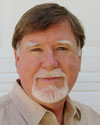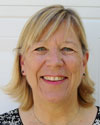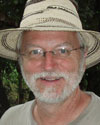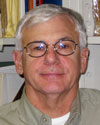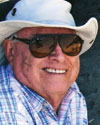2010 E.B. Burwell, Jr. Awardfor their article titled "Geology of Los Angeles, California, USA"in the March 2007 issue of Environmental & Engineering Geology (v. XIII:2, pp. 99-160). Presented to … |
||||
[ view response ] |
|
|
|
|
Citation by J. David Rogers
This year’s Burwell Award winning article has a simple title that understates the profound effect that Los Angeles has had on the profession of engineering geology, perhaps more than any other city in the world. Bringing together all the diverse aspects that geology plays in development of this large and sprawling city has been admirably done by the authors and will serve the engineering geology community of Southern California as an important resource for many years to come.
There is much about Los Angeles that has affected the profession of engineering geology, perhaps more than any other city. The need for infrastructure was evident soon after its founding, given its agreeable climate coupled with the shortage of water; a population boom, with its consequent transportation requirements; and recurring large earthquakes amid the rumble of smaller, stress-relieving tremors. The development of Los Angeles recounts a story that highlights the fact that technical expertise is constantly needed to meet the challenges of urban development in an environmentally changing and tectonically active area.
This article does a superb job of explaining how the various geohazards threatening the greater Los Angeles Basin were discovered, beginning with the 1915 Los Angeles County Flood Control Act, the adoption of the Uniform Building Code in 1927, the 1929 California Dam Safety Act, the 1933 Long Beach Earthquake, which prompted passage of the Riley and Field Acts regulating seismic design considerations, the Engineering Geologists Qualifications Board established by the City of Los Angeles in 1958, the 1971 San Fernando Earthquake which led to passage of the Alquist-Priolo Act in 1972 and the Seismic Safety Act of 1975, the 1990 Seismic Hazards Mapping Act, and the numerous modifications to the Uniform Building Code for seismic safety, most of which came about in the 1990s, after the 1989 Loma Prieta and 1994 Northridge earthquakes.
The countless geohazards which impact Los Angeles development arise in large part from its being situated along one of the world’s most active tectonic boundaries, between the Pacific and North American continental plates. Much of the city’s sprawling infrastructure lies upon an enormous sedimentary basin, filled with 30,000 ft (9,100 m) of mostly shallow marine sediments of late tertiary and Quaternary age. Virtually all of the major challenges that have impacted the practice of engineering and environmental geology, as well as engineering seismology, have been profoundly impacted by what has transpired in and around Los Angeles over the past 100 years. That the area presently supports a population base of roughly 17 million people is stark testament to its importance as a commercial center. And, the area continues to grow. The Port of Los Angeles/Long Beach now imports about 25% of the seaborne commerce entering the continental United States.
Los Angeles has become, in essence, a model American city because the great majority of its structures have been built after the initial adoption of building codes with strict seismic design tenants, beginning in 1933. Three-fourths of the city’s structures have been constructed since 1945 using increasingly demanding building codes. In addition, LA was the first city to require grading and excavation permits (1952), engineering geologic input (1958), special design considerations for landslide mitigation (1967), surface fault setbacks (1972), liquefaction assessments (1991),and tsunami run-up (2006). All of these improvements were driven by the political fallout of high-visibility failures, either within their jurisdiction or elsewhere (such as the 2004 Andaman Islands tsunami). It is likely that Los Angeles will continue to maintain a leading position in developing increasingly safe building codes as they await the ultimate test, when a large magnitude earthquake emanates from the southern San Andreas fault.
Brief biographies of the co-authors
William (Bill) Bilodeau is a geology professor at California Lutheran University in Thousand Oaks, California. After completing his BA at the University of California, Santa Barbara in 1973 and his Ph.D. at Stanford University in 1979, he began his teaching career at the University of Colorado at Denver. His research interests lie in the areas of structural geology, regional tectonics, clastic sedimentation and stratigraphy. Since coming to California Lutheran University in 1990 he has strengthened the field aspects of the geology program, introducing new courses in geophysics and introductory oceanography. In his 20 years at CLU, Bill has always fostered a field-based approach to his classes, and leading annual field trips to Death Valley and Owens Valley/Eastern Sierra in his introductory Physical Geology course. He also leads international Travel/Study Seminar trips each year, which have allowed him to take students, alumni, faculty and interested geologists to places like Costa Rica, Belize, Ecuador and the Galapagos, Italy and Sicily, Turkey and Greece, New Zealand and to Australia. His favorite destination is the Grand Canyon, where he will be leading his 13th raft trip in June 2011.
Sally Bilodeau is a California Professional Geologist (PG), Certified Engineering Geologist (CEG) and Certified Hydrogeologist (CHG), and a Certified Environmental Manager in Nevada. She has over 30 years of experience in the environmental field and specializes in RCRA permitting, assessment, and corrective action. She received her BA in Earth Science from California State University-Fullerton and obtained her MS in Applied Earth Science from Stanford University. She has been with AECOM (and ENSR) since 2000. She originally worked as an engineering geologist assessing geologic hazards associated with land development and later became involved in cleaning up hazardous waste sites. She has publications ranging from fault studies in Guatemala to Groundwater Monitoring of US Landfills. For the Cities of the World Series that the Association of Engineering Geologists (AEG) started in 1980, she has co-authored three papers, Geology of Denver, Geology of Boulder, and most recently Geology of Los Angles. She is a past recipient of the AEG best paper of the year awards in 1983 and 1988.
Eldon Gath is President of Earth Consultants International, which he founded in 1997. Previous to this he was Principal Geologist with Leighton & Associates. He also served as President of the Association of Engineering Geologists in 1996-97. He has a BS in Geology from the University of Minnesota (1978), complimented by 29 years of post-graduate education at various Southern California institutions, and holds Professional Geologist and Engineering Geologist licenses in California. He has worked extensively on engineering geologic projects, community planning, and seismic hazard studies in Southern California, but has also completed multiple projects in Turkey, Japan, and Taiwan, plus for the last five years has been heavily involved with paleoseismic studies and seismic risk models for the Panama Canal expansion. He has served on many steering and guidance committees including for the National Academy of Sciences, NEHRP, USGS, Los Angeles County, and many professional organizations. He is a Member of AEG, GSA, AAPG, AGU, SSA, EERI, IAEG, and several local geological organizations in southern California.
Mark Oborne is a senior engineering geologist with the Geotechnical Group of the Department of Public Works for the City of Los Angeles. He obtained his Bachelors (1978) and Masters (1982) degrees in Geoscience from California State University at Northridge specializing in structural geology and stratigraphic analysis. He is a licensed professional geologist and Certified Engineering Geologist in California and has worked as a geologist in the southern California area for over 30 years with an emphasis on land development and later on public works projects for the City of Los Angeles. He has authored and co-authored publications regarding active faulting, landslides, and geologic investigations for tunnels.
Richard J. “Dick” Proctor grew up in southern California and received his BS in geology from UCLA in 1954, when he joined the Metropolitan Water District as their first geologist on their payroll. After service in the Army he returned to UCLA for a MS degree (1958), when he joined the newly formed California Association of Engineering Geologists. By 1963 he was MWDs chief geologist with a staff of 12 geologists, working on an extensive program of tunnels and aqueduct extensions associated with the California Water Project and the Colorado River Aqueduct, before retiring in 1979. During those formative years he also served as Chairman of the Los Angeles County Engineering Geologists Review Board and the U.S. National Committee on Tunneling Technology. He co-edited the landmark volume “Engineering Geology in Southern California” for AEG in 1966, wrote AEG’s first Professional Practice Guidelines (1981), and co-edited “Engineering Geology Practice in Southern California,” published by AEG in 1992. In the 1970s he became a Visiting Associate Professor of Geology at Caltech, as well as a consulting geologist for Lindvall-Richter in Pasadena. Dick served as President of the Association of Engineering Geologists in 1980 and is a previous recipient of the E.B. Burwell Award (1972), the AIPG Van Couvering Award (1990), AEG’s Holdrege Award (1995), AEG Publication Award (1998), AIPG Parker Medal (2003), and Honorary Member of AEG (2004).
 2010 E.B. Burwell, Jr. Award — Response by William Bilodeau
2010 E.B. Burwell, Jr. Award — Response by William Bilodeau
On behalf of my co-authors, I can honestly say we were all pleasantly surprised and are highly honored to receive the E.B. Burwell Jr. Award for 2010. We would like to thank both the Awards Committee and the Engineering Geology Division of the Geological Society of America for this Award. In addition, we would like to thank Dave Rogers for his citation and particularly thank Allen Hatheway who got us all started on this road.
This paper got its start with Eldon Gath at the helm long before I became involved in it. Sally and I joined in the effort around 1996. Allen Hatheway, as editor of the “Cities of the World” series, asked Sally to see if she could help get the paper moving as she had experience in writing two other papers on the geology of major cities, Denver and Boulder, Colorado. Allen thought Sally, with her charm and enthusiasm, could spark renewed writing on the project. The paper had quite a few co-authors involved but they were all just too busy to get it done. Sally was given the green light to reorganize and reassign duties and deadlines. She brought me in to write the sedimentology/stratigraphy and regional tectonic history but we soon realized there was more that needed to be done. Eldon Gath and Richard Proctor were the only two survivors of the original authors from the first go-round. Eldon is the expert on Southern California earthquakes and kept us current on the latest information coming out of the Southern California Earthquake Center and active tectonics in general. Richard is an old hand at this and has received the Burwell Award before. He was a great source for providing the historic stuff like old photos and information on historic landslides, tunnels, the San Fernando Earthquake and Fairfax methane explosions. He also provided the most entertaining stories and essential insider knowledge about the fathers of Los Angeles engineering geology. Mark Oborne provided key governmental access to the City of Los Angeles map files and area specific information that kept us honest about editorializing about certain high profile hazards due to pending lawsuits. Sally had hoped to pull it all together but realized that she was just too busy at work (the paper had languished for several years). I had a sabbatical coming up in early 2006 and volunteered to respond to review comments and assemble it all. Once it was accepted for publication, the journal editors wanted the final copy in time to publish it before the 2007 annual meeting of the Association of Engineering Geologists which was to be held in Los Angeles that year. We just made it. Despite the work being a marathon effort it was very gratifying to finally assemble a detailed picture of the geology of Los Angeles and the evolution of the practice of engineering geology as experienced in Los Angeles.

